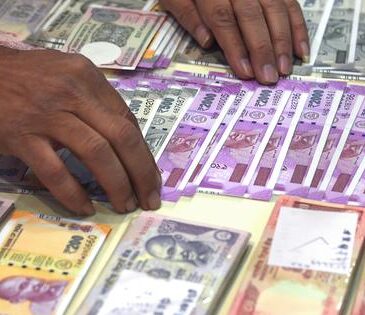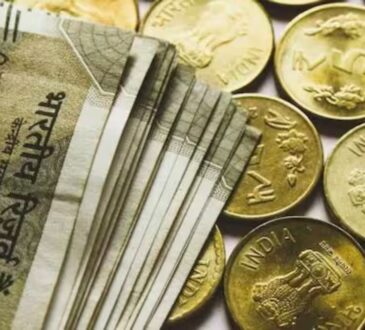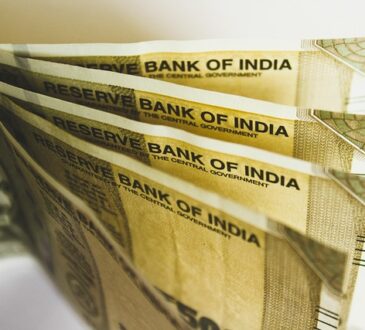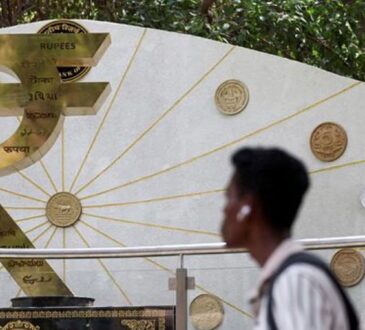- EUR/USD trades little changed on the day near 1.1250.
- The pair needs to stabilize above 1.1270 to gather bullish momentum.
- Market participants will pay close attention to comments from central bankers.
EUR/USD fluctuates in a narrow channel at around 1.1250 in the European session on Tuesday after closing in positive territory on Monday. The near-term technical outlook points to a loss of bullish momentum as the key resistance level at 1.1270 stays intact.
Euro PRICE This week
The table below shows the percentage change of Euro (EUR) against listed major currencies this week. Euro was the strongest against the US Dollar.
| USD | EUR | GBP | JPY | CAD | AUD | NZD | CHF | |
|---|---|---|---|---|---|---|---|---|
| USD | -0.65% | -0.67% | -0.59% | -0.25% | -0.22% | -0.65% | -0.60% | |
| EUR | 0.65% | -0.04% | 0.08% | 0.47% | 0.56% | 0.07% | 0.06% | |
| GBP | 0.67% | 0.04% | -0.15% | 0.51% | 0.58% | 0.11% | 0.10% | |
| JPY | 0.59% | -0.08% | 0.15% | 0.36% | 0.55% | 0.16% | 0.06% | |
| CAD | 0.25% | -0.47% | -0.51% | -0.36% | 0.04% | -0.40% | -0.41% | |
| AUD | 0.22% | -0.56% | -0.58% | -0.55% | -0.04% | -0.49% | -0.49% | |
| NZD | 0.65% | -0.07% | -0.11% | -0.16% | 0.40% | 0.49% | -0.01% | |
| CHF | 0.60% | -0.06% | -0.10% | -0.06% | 0.41% | 0.49% | 0.01% |
The heat map shows percentage changes of major currencies against each other. The base currency is picked from the left column, while the quote currency is picked from the top row. For example, if you pick the Euro from the left column and move along the horizontal line to the US Dollar, the percentage change displayed in the box will represent EUR (base)/USD (quote).
The US Dollar (USD) started the week under selling pressure and EUR/USD edged higher after Moody’s announced late Friday that it downgraded the United States’ credit rating.
Meanwhile, comments from Federal Reserve (Fed) policymakers seem to be helping the USD find a foothold and capping EUR/USD’s upside. Atlanta Fed President Raphael Bostic reiterated that he expects the Fed to lower the policy rate once this year, while Fed Vice Chairman Philip Jefferson and Minneapolis Fed President Neel Kashkari both argued that they need to remain patient with regard to policy adjustments and wait for more information.
In the absence of high-tier data releases, market participants will pay close attention to comments from Fed and European Central Bank (ECB) officials.
ECB board member Isabel Schnabel said on Tuesday that disinflation is on track but added that tariffs may pose upside inflation risks over the medium term.
In case ECB policymakers refrain from hinting at another rate cut in June, the Euro could hold its ground. On the other hand, EUR/USD could stretch lower if Fed officials voice a preference for only one rate cut in 2025.
Later in the day, the European Commission will publish the preliminary Consumer Confidence Index data for May, which is unlikely to have a noticeable impact on the Euro’s valuation.
EUR/USD Technical Analysis
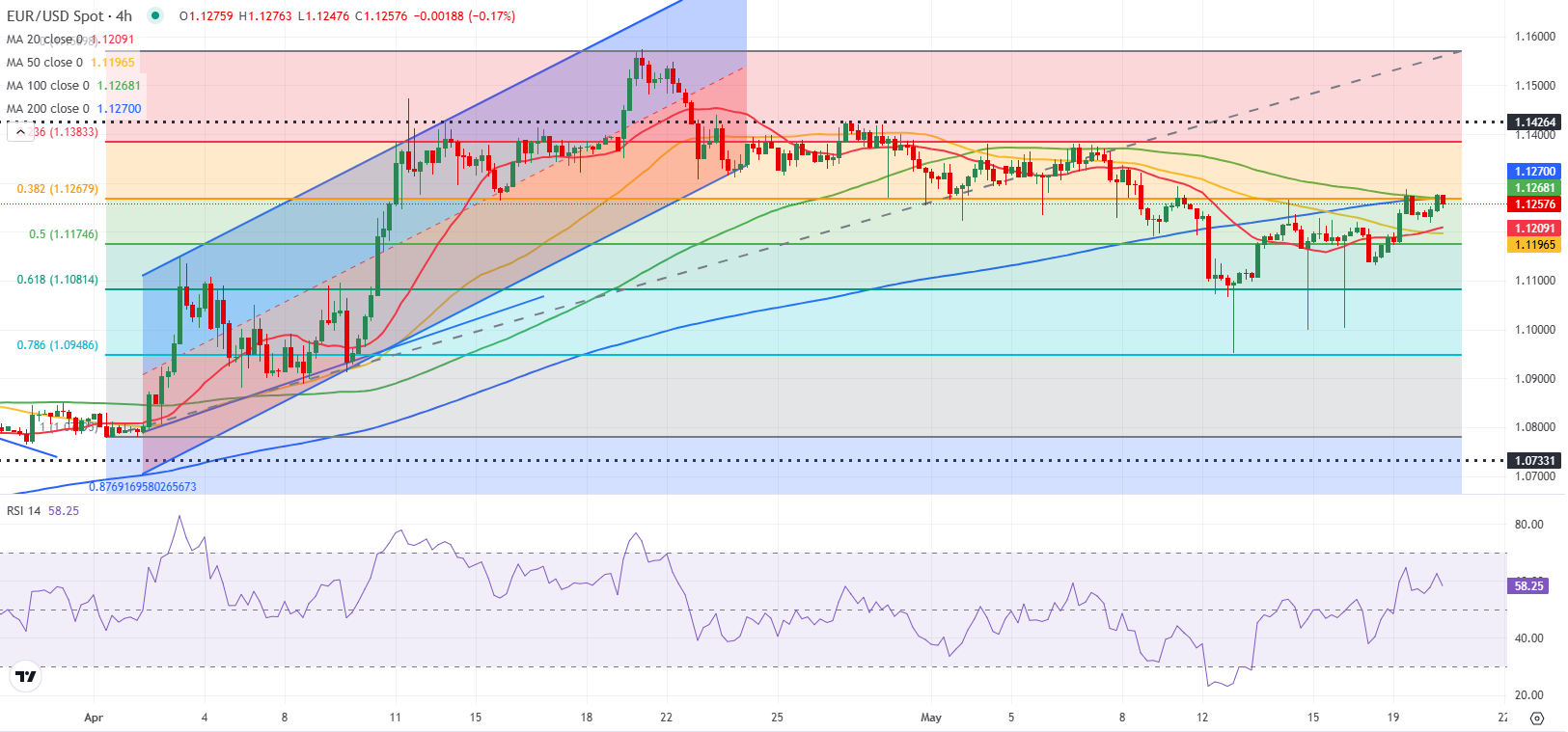
The Relative Strength Index (RSI) indicator on the 4-hour chart declined below 60, pointing to a loss of bullish momentum.
EUR/USD faces immediate resistance at 1.1270, where the Fibonacci 38.2% retracement of the latest uptrend, 100-period Simple Moving Average (SMA) on the 4-hour chart and the 200-period SMA converge. In case the pair rises above this level and confirms it as support, technical buyers could show interest. In this scenario, 1.1300 (static level) could be seen as interim resistance before 1.1380 (Fibonacci 23.6% retracement).
On the downside, 1.1200 (static level, round level) aligns as the first support level ahead of 1.1170 (Fibonacci 50% retracement) and 1.1080 (Fibonacci 61.8% retracement).
Euro FAQs
The Euro is the currency for the 19 European Union countries that belong to the Eurozone. It is the second most heavily traded currency in the world behind the US Dollar. In 2022, it accounted for 31% of all foreign exchange transactions, with an average daily turnover of over $2.2 trillion a day.
EUR/USD is the most heavily traded currency pair in the world, accounting for an estimated 30% off all transactions, followed by EUR/JPY (4%), EUR/GBP (3%) and EUR/AUD (2%).
The European Central Bank (ECB) in Frankfurt, Germany, is the reserve bank for the Eurozone. The ECB sets interest rates and manages monetary policy.
The ECB’s primary mandate is to maintain price stability, which means either controlling inflation or stimulating growth. Its primary tool is the raising or lowering of interest rates. Relatively high interest rates – or the expectation of higher rates – will usually benefit the Euro and vice versa.
The ECB Governing Council makes monetary policy decisions at meetings held eight times a year. Decisions are made by heads of the Eurozone national banks and six permanent members, including the President of the ECB, Christine Lagarde.
Eurozone inflation data, measured by the Harmonized Index of Consumer Prices (HICP), is an important econometric for the Euro. If inflation rises more than expected, especially if above the ECB’s 2% target, it obliges the ECB to raise interest rates to bring it back under control.
Relatively high interest rates compared to its counterparts will usually benefit the Euro, as it makes the region more attractive as a place for global investors to park their money.
Data releases gauge the health of the economy and can impact on the Euro. Indicators such as GDP, Manufacturing and Services PMIs, employment, and consumer sentiment surveys can all influence the direction of the single currency.
A strong economy is good for the Euro. Not only does it attract more foreign investment but it may encourage the ECB to put up interest rates, which will directly strengthen the Euro. Otherwise, if economic data is weak, the Euro is likely to fall.
Economic data for the four largest economies in the euro area (Germany, France, Italy and Spain) are especially significant, as they account for 75% of the Eurozone’s economy.
Another significant data release for the Euro is the Trade Balance. This indicator measures the difference between what a country earns from its exports and what it spends on imports over a given period.
If a country produces highly sought after exports then its currency will gain in value purely from the extra demand created from foreign buyers seeking to purchase these goods. Therefore, a positive net Trade Balance strengthens a currency and vice versa for a negative balance.

